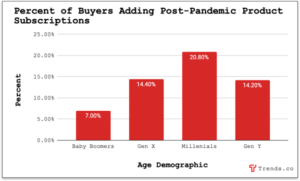
A Retail Revolution: A-Commerce
As we all know by now, COVID has changed a lot about the way we live, work, and shop. In fact, 7-20% of buyers in different age groups signed up for more product subscriptions to manage purchasing in the wake of the issues caused by the pandemic. That, combined with other changes in buyer behavior, is ushering in a paradigm-shifting possibility in the way we do business: a-commerce.

What’s trending?
Automated shopping technology (A-commerce) reduces or eliminates the need for the shopper to be consciously involved in purchase decisions. A-commerce is the next evolution of retail in which companies use connected devices to monitor customer activity and automatically ship products before buyers ever realize they need something.
Think a printer that automatically orders ink when levels get low, or a Nespresso that sends your favorite coffee pods straight to your door when it knows you’re nearly out.
This innovation rewrites the story of retail as we know it, shifting the purchase decision from the buyer to the seller, and is building on two ongoing trends:
- Booming Subscription Market: People want to buy on autopilot. From 2014 to 2018 the ecommerce subscription market grew at 60% CAGR to an estimated $12B to $15B, according to McKinsey, with lots of room left for continued growth.
- Voice Commerce: People are increasingly willing to let smart devices like Amazon’s Alexa help in the buying process. A report by Voicebot.ai found that ~4% of smartspeaker owners use them to purchase products daily, while 15% make purchases monthly.
A-commerce combines the two, enabling smart devices to order products without conscious manual input, and in the process, offers buyers a more convenient experience while helping sellers decrease friction, improve sales forecasting, and boost recurring orders.
Why is it important?
As the Internet changes from a text-based platform to a voice-activated platform, retail – that is the shopping experience – is destined to become even more entrenched in our daily lives. Shopping may become something that we don’t always do consciously ourselves, but rather have done for us through in-home smart AI technology. Retailers will increasingly find themselves selling to algorithms as well as humans.
The popularity of auto-renew subscription box services such as beauty start-up Ruby Box and organic produce company, Munching Mongoose , in South African and multi-million dollar enterprise, The Dollar Shave Club in the US, are early examples of the trend.
Now advances in predictive algorithms, blockchain smart-contract technology and secure payment systems are pushing the trend beyond opt-in subscription services and into fully automated commerce systems.
The key is to save shoppers time and make purchasing seamless and simple.
What’s happening?
While this is still a nascent technology, there are already several opportunities worth exploring:
A-commerce At Home: The smart-home market was valued at $64B in 2019, and is projected to quadruple by 2025, according to Mordor Intelligence. Companies that produce smart devices can equip them with a-commerce abilities in order to stand out to customers.
Tools like Amazon Dash Replenishment, a service that can be integrated into devices, enables products to be automatically ordered from Amazon when supplies are running low.
Companies like Wagz (automatic dog feeder) and Epson (printers) use Dash in their devices, and highlight their automatic dog food or ink reordering features as major selling points.
There’s also an opportunity to create ancillary products that add value to existing appliances. Weplenish, for example, is a smart container that tracks your inventory of coffee pods. When supply runs low, the device automatically orders more.
Similarly, Absolute Vodka’s prototype smart bottles and bars can be programmed to re-order liquor when the liquid in the bottle drops to a certain level.
A-commerce on the Go: A-commerce isn’t limited to bulky home appliances — there’s one smart device that 45% of the world’s population carries with them everywhere. Companies are now experimenting with services that are automatically triggered using some of the many sensors that smartphones have onboard.
Revolut, the $5.5B fintech company, recently launched pay-per-day travel insurance, which automatically kicks in any time the user’s phone travels abroad. By using the phone’s geolocation features plus automation, customers pay only for the days they’re actually abroad without ever having to think about it.
This reveals something important about quality a-commerce opportunities: They will likely be found in industries that are crucial, yet tedious to shop. Not having insurance abroad exposes you to enormous risk. But buying it is a hassle, so many don’t. Solutions that bridge similar gaps automatically will prove promising as a-commerce is adopted more broadly.
Smartphones are loaded with other types of sensors that can offer companies unique a-commerce connections with clients.
Consider the importance of mental health, another trending topic. One in five adults face a mental health issue in any given year, yet most never get treatment. Perhaps there’s a market for a telepsychology service that automatically books a session when the heart rate sensor on a user’s phone is above baseline for too many days in a row.
Seller Services: If a-commerce takes off, it will rewrite the rulebook on retail, reports Flux: “Retailers will increasingly find themselves selling to algorithms as well as humans.”
The Opportunity?
Get out there and start talking with the pioneers in the arena and just as important, keep your eyes peeled for more a-commerce brands to develop in the coming couple of short years. Finally, if you have a current client that could integrate the automated shopping technology with their brand, you may be opening up a whole new revenue stream for them.
Prospect smAARt, pitch with purpose, and most importantly, with passion.